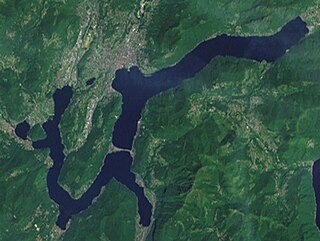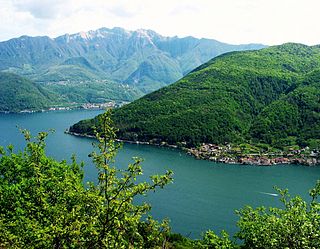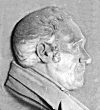
S. Giorgio Castle is a castle in the municipality of Magliaso in the Swiss canton of Ticino. It is a Swiss heritage site of national significance. [1]

S. Giorgio Castle is a castle in the municipality of Magliaso in the Swiss canton of Ticino. It is a Swiss heritage site of national significance. [1]
The medieval castle of San Giorgio [2] is mentioned for the first time in 1033. It was the home for nearly two decades (1098-1117) for the schismatic bishop of Como, Landolfo Carcano, who was appointed by Emperor Henry IV against Pope Gregory VII's bishop. [3] The castle was besieged and conquered in 1117 by Como and the fate of Landolfo, is uncertain (possibly deported or murdered). This caused the ten-year war between Como and Milan. In 1667 Giovanni Maria Castoreo di Lugano sold the castle with its surrounding land to the Beroldingen family. Carlo Corrado Beroldingen added, in 1687, to the west, the residential tower next to the medieval tower. It was partially destroyed in 1907.
The square tower on the south wall still has fragments of a Romanesque spiral decoration. [3] In the north-west wall there are remains of a semi-circular brick wall. The two lines of the Beroldingen family passed from father to son the office of Landscriba (Chancellor) of the bailiwick of Lugano and Mendrisio. Beroldingen di Magliaso family, also received, in fief, the territory of the Vicinanza with all the rights to hunting, fishing, and low justice. After Carlo Corrado, who at the height of his fortune also owned two buildings in Lugano (Villa Favorita and Villa Ciani), the family fortune rapidly declined and they fell further and further into debt. In 1788 the Baron Giuseppe Antonio Beroldingen (fourth lord of Magliaso) gave the castle to Jost Müller of Altdorf, who kept it until 1798.

Como is a city and comune in Lombardy, Italy. It is the administrative capital of the Province of Como.

Ticino, sometimes Tessin, officially the Republic and Canton of Ticino or less formally the Canton of Ticino, is one of the 26 cantons forming the Swiss Confederation. It is composed of eight districts and its capital city is Bellinzona. It is also traditionally divided into the Sopraceneri and the Sottoceneri, respectively north and south of Monte Ceneri. Red and blue are the colours of its flag.

Lugano is a city and municipality in Switzerland, part of the Lugano District in the canton of Ticino. It is the largest city of both Ticino and the Italian-speaking southern Switzerland. Lugano has a population of 62,315, and an urban agglomeration of over 150,000. It is the ninth largest Swiss city.

Lake Lugano is a glacial lake which is situated on the border between southern Switzerland and northern Italy. The lake, named after the city of Lugano, is situated between Lake Como and Lago Maggiore. It was cited for the first time by Gregory of Tours in 590 with the name Ceresio, a name which is said to have derived from the Latin word cerasus, meaning cherry, and refers to the abundance of cherry trees which at one time adorned the shores of the lake. The lake appears in documents in 804 under the name Laco Luanasco.

Gandria is both a quarter of the city of Lugano in the Swiss canton of Ticino, and a village on the northern shore of Lake Lugano, which forms the core of that quarter. Until 2004, the quarter of Gandria was an independent municipality, joining with Lugano in that year.

Bellinzona is a municipality, a historic Swiss town, and the capital of the canton of Ticino in Switzerland. The town is famous for its three castles that have been UNESCO World Heritage Sites since 2000.

Carpoforo Tencalla was an influential Swiss-Italian Baroque painter of canvases and frescoes. He is little studied and has come only recently to the attention of art critics and historians. He introduced 17th-century Italian painting style with its mythological subjects to Central Europe, reviving the art of fresco on large surfaces.

Grosio is a comune (municipality) in the Province of Sondrio in the Italian region Lombardy, located about 130 kilometres (81 mi) northeast of Milan and about 35 kilometres (22 mi) northeast of Sondrio, on the border with Switzerland.

Capolago is a village situated at the south-eastern extremity of Lake Lugano, in the Swiss canton of Ticino. Originally a municipality in its own right, Capolago is now a quarter of the municipality of Mendrisio, itself part of the district of Mendrisio.
Magliaso is a municipality in the district of Lugano in the canton of Ticino in Switzerland.

Monte San Giorgio is a mountain and UNESCO World Heritage Site on the border between Switzerland and Italy. It is part of the Lugano Prealps, overlooking Lake Lugano in the Swiss Canton of Ticino.

Visconti Castle Italian: Castello Visconteo is a castle in Locarno, Switzerland. It is a Swiss heritage site of national significance.

Giacomo Moraglia was a prolific Italian architect in the late Neoclassical period, remembered above all for his Porta Comasina in Milan.

Giorgio Orelli was an Italian-speaking Swiss poet, writer and translator.

Saint Lucius in Brugherio, Italy, is a small church dedicated to Saint Lucius in the grounds of the Villa Sormani. First located in Lugano, Switzerland, where it was a Franciscan chapel, the building was disassembled and transported to Brugherio, where its reconstruction was completed 17 years later.
Carlo Giuseppe Plura was a Swiss-Italian stucco artist and sculptor. He was born in Lugano and died in Borgo San Dalmazzo. Like him, his son Giuseppe Antonio Plura the Elder and Giuseppe Plura the Younger were both sculptors and both active in the United Kingdom.

Matteo Castelli was a Swiss architect. His nephew Costante Tencalla also became an architect.

Costante Tencalla was a Swiss-Italian architect and sculptor.
The war of Milan against Como, sometimes called the 10-Year War, was a conflict over the control of Insubria, Brianza and Valtellina in the early 12th century, fought between the comuni of Milan and Como. It resulted in the defeat and destruction of the latter, cementing Milan's position as the dominant power in Lombardy.